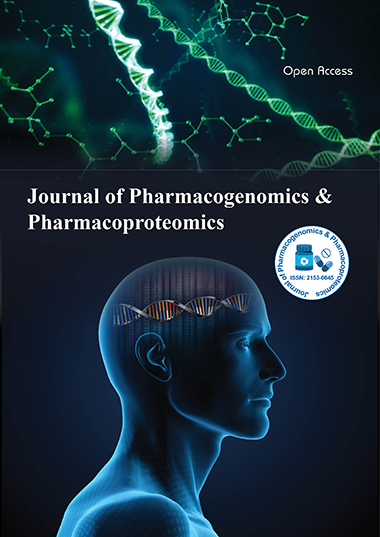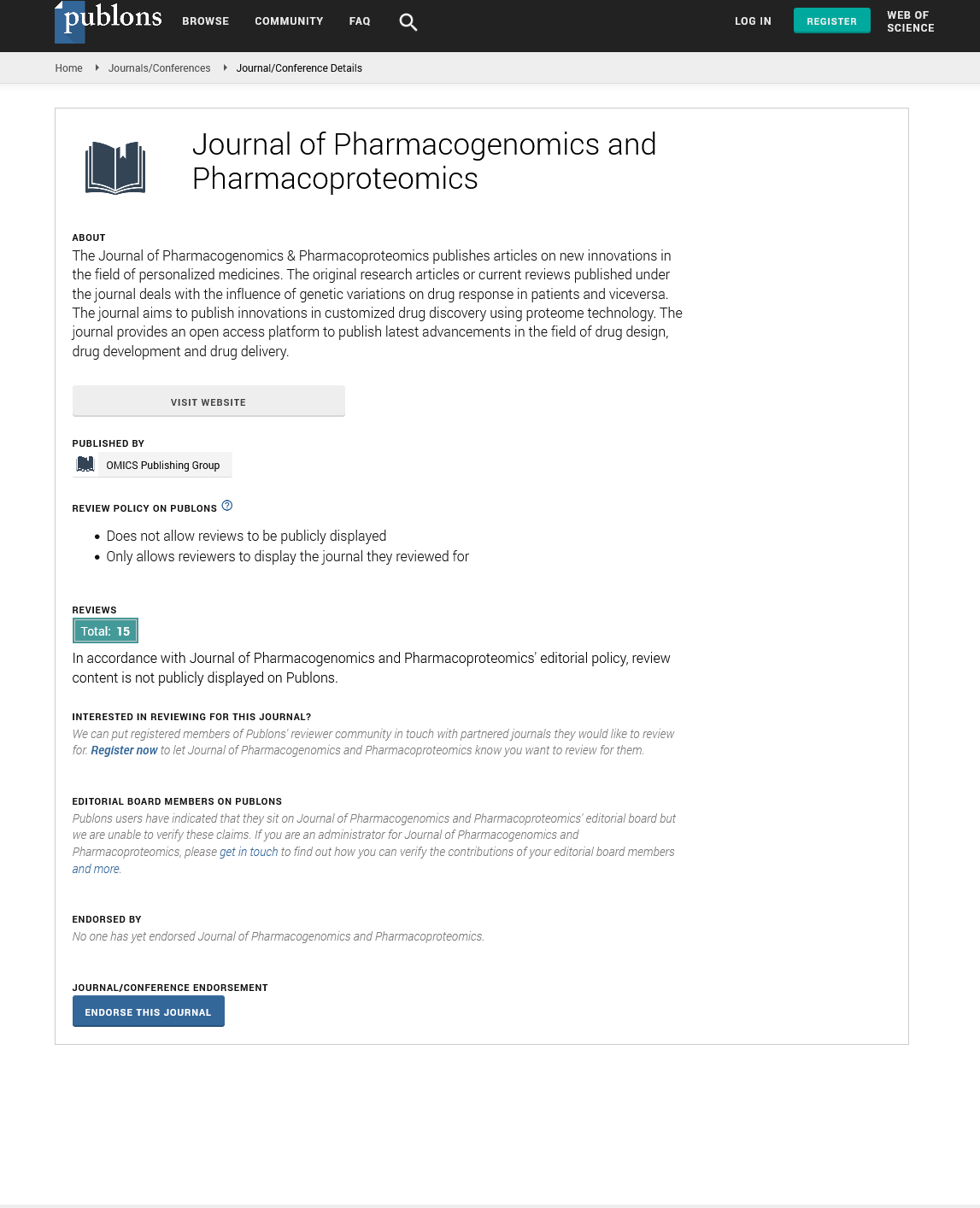Indexed In
- Open J Gate
- Genamics JournalSeek
- Academic Keys
- JournalTOCs
- ResearchBible
- Electronic Journals Library
- RefSeek
- Hamdard University
- EBSCO A-Z
- OCLC- WorldCat
- Proquest Summons
- SWB online catalog
- Virtual Library of Biology (vifabio)
- Publons
- MIAR
- Euro Pub
- Google Scholar
Useful Links
Share This Page
Journal Flyer

Open Access Journals
- Agri and Aquaculture
- Biochemistry
- Bioinformatics & Systems Biology
- Business & Management
- Chemistry
- Clinical Sciences
- Engineering
- Food & Nutrition
- General Science
- Genetics & Molecular Biology
- Immunology & Microbiology
- Medical Sciences
- Neuroscience & Psychology
- Nursing & Health Care
- Pharmaceutical Sciences
Commentary - (2022) Volume 13, Issue 5
Pharmacogenomics Testing in the Clinical Management of Opioid Use Disorder
Jain Casen*Received: 01-Sep-2022, Manuscript No. JPP-22-18207; Editor assigned: 05-Sep-2022, Pre QC No. JPP-22-18207(PQ); Reviewed: 19-Sep-2022, QC No. JPP-22-18207; Revised: 26-Sep-2022, Manuscript No. JPP-22-18207(R); Published: 03-Oct-2022, DOI: 10.35248/2153-0645.22.13.021
Description
Genomics are the investigation of structure, functions, and expression methods of every gene in an organism. Proteomics are large scale study of proteins, including their structure and function, within the cell/system, organism. The science of drug kinetics and dynamics are response to the genes and their functions. Pharmacology genomics clinical pharmacogenomics testing brings to the science of pharmacogenomics and it is use of several opioid prescriptions from various providers, drug behavior, and legal repercussions due to opioid usage are all indications of opioid use disorder. Additionally, there is a number of health issues associated with opioid use, as well as opioid cravings, rising opioid usage with time, and withdrawal symptoms from opioid use [1].
The use of opioids along with the recurrence of two or more of the eleven problems within a 12-month period constitutes an opioid use disorder. The issues include opioid withdrawal after stopping use, losing essential life experiences, and utilising opioids for an excessive amount of time. The person's opioid use has also resulted in considerable disability or suffering. A serious condition is indicated by six or more diagnostic criterion items. OUD diagnostic criteria using larger amounts of opioids or over a longer period than was intended both non pharmacological and pharmaceutical methods are used to treat OUD both pharmacological and non pharmacological techniques use Medication Assisted Treatment (MAT) with methadone, Buprenorphine (BUP). Non pharmacological approaches involve Cognitive Behavioral Therapy (CBT), such as 12-step programs (XR-NTX) [2].
Despite the availability of MAT alternatives for OUD therapy, some patients report inconsistent treatment outcomes that may be due to a number of factors, including care barriers and genetic polymorphisms or inter individual genetic variations to find genetic targets of interest that impact MAT response, clinical practice can use Pharmacogenomics (PGx), a field that combines pharmacology and genomics to explore how genetic variants affect medication reaction. Both the Pharmacokinetics (PK) and the Pharmacodynamics (PD) of a particular medicine can be impacted by genetic variations. Clinical PGx testing can help to clarify how genetic variants affect the drugs used to treat OUD in a particular patient and enable medical professionals to customise medication selection and dosage. However, there are numerous obstacles that make it difficult to perform this testing procedure. The lack of real world data that medical professionals may use to improve clinical decision making is one such barrier. A patient with the CYP3A4 UM phenotype needed a higher-than recommended daily dose of BUP (32 mg) for effective OUD control, according to a published case-report by our research group [3].
Treatment/management there are numerous methods for the maintaining and rehabilitating individuals who are using opioids. A cognitive behavioral technique, like those used in the treatment of other chronic illnesses, is employed to start the rehabilitation process. Programs for maintenance must to offer psychological assistance [4]. Through education, incentives for collaboration, and drugs, patients are motivated to change. Relapse into drug use is the least desirable outcome of therapy. The participation of patients with substance use disorders in selfhelp groups like alcoholics anonymous and narcotics anonymous is encouraged. The combination of education, motivational enhancement, and self-help groups helps patients change how they think about the ways that opioids affect their lives. Opioid maintenance, replacement, or substitution therapy involves replacing from one opioid to another that has a longer-acting but less euphoric and addictive. Buprenorphine and methadone are the most often used medications [5].
REFERENCES
- Zhou Y, Tremmel R, Schaeffeler E, Schwab M, Lauschke VM. Challenges and opportunities associated with rare-variant pharmacogenomics. Trends Pharmacol Sci. 2022; 43:852-865.
[Crossref] [Google Scholar] [PubMed]
- Klanderman BJ, Koch C, Machini K, Parpattedar SS. Automated pharmacogenomics reports for clinical genome sequencing. J Mol Diagn. 2022; 24:205-218.
[Crossref] [Google Scholar] [PubMed]
- Siamoglou S, Koromina M, Hishinuma E, Yamazaki S, Tsermpini EE. Identification and functional validation of novel pharmacogenomics variants using a next-generation sequencing-based approach for clinical pharmacogenomics. Pharmacol Res. 2022;176:106087.
[Crossref] [Google Scholar] [PubMed]
- Keeling NJ, Dunn TJ, Bentley JP, Ramachandran S, Hoffman JM, Rosenthal M. Approaches to assessing the provider experience with clinical pharmacogenomics information: a scoping review. Genet Med. 2021; 23:1589-1603.
[Crossref] [Google Scholar] [PubMed]
- Liu D, Olson KL, Manzi SF, Mandl KD. Patients dispensed medications with actionable pharmacogenomics biomarkers: rates and characteristics. Genet Med. 2021; 23:782-786.
[Crossref] [Google Scholar] [PubMed]
Citation: Casen J (2022) Pharmacogenomics Testing in the Clinical Management of Opioid Use Disorder. J Pharmacogenom Pharmacoproteomics. 13:021.
Copyright: © 2022 Casen J. This is an open-access article distributed under the terms of the Creative Commons Attribution License, which permits unrestricted use, distribution, and reproduction in any medium, provided the original author and source are credited.

